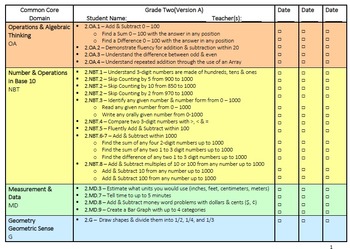Second Grade Common Core Math Assessment: Benchmark or Diagnostic
Mathemagicians and Word Wizards Enter Here
89 Followers
Grade Levels
K - 3rd
Subjects
Resource Type
Standards
CCSS2.MD.A.1
CCSS2.NBT.A.1
CCSS2.NBT.A.2
CCSS2.NBT.A.3
CCSS2.NBT.A.4
Formats Included
- PDF
Pages
12 pages
Mathemagicians and Word Wizards Enter Here
89 Followers
What educators are saying
This is a great assessment to use to find out where your students are at in all the math strands. I trach math intervention k-6 and have this assessment tool for all grade levels.
Loved the break down for each ccss and it's meaning. Thank you for this product! Let's me look at the differences for 2nd grade.
Description
Mathemagicians and Word Wizards Enter Here for a Second Grade Common Core Math Assessment. This test has multiple intended uses. Including:
1. Ensuring an end of the year 2nd grader mastered all the Common Core Standards. (Summative Assessment)
2. Ensuring a beginning 3rd grader mastered each of the 2nd grade Common Core Standards (Summative Assessment)
3. Placing a 2nd grader into an enrichment group. (Screening Assessment) and
4. Determining intervention areas needed to be covered for a student with specialized designed instruction.
(Diagnostic and Progress Monitoring Assessment)
1. Ensuring an end of the year 2nd grader mastered all the Common Core Standards. (Summative Assessment)
2. Ensuring a beginning 3rd grader mastered each of the 2nd grade Common Core Standards (Summative Assessment)
3. Placing a 2nd grader into an enrichment group. (Screening Assessment) and
4. Determining intervention areas needed to be covered for a student with specialized designed instruction.
(Diagnostic and Progress Monitoring Assessment)
Total Pages
12 pages
Answer Key
Included
Teaching Duration
30 minutes
Report this resource to TPT
Reported resources will be reviewed by our team. Report this resource to let us know if this resource violates TPT’s content guidelines.
Standards
to see state-specific standards (only available in the US).
CCSS2.MD.A.1
Measure the length of an object by selecting and using appropriate tools such as rulers, yardsticks, meter sticks, and measuring tapes.
CCSS2.NBT.A.1
Understand that the three digits of a three-digit number represent amounts of hundreds, tens, and ones; e.g., 706 equals 7 hundreds, 0 tens, and 6 ones. Understand the following as special cases:
CCSS2.NBT.A.2
Count within 1000; skip-count by 5s, 10s, and 100s.
CCSS2.NBT.A.3
Read and write numbers to 1000 using base-ten numerals, number names, and expanded form.
CCSS2.NBT.A.4
Compare two three-digit numbers based on meanings of the hundreds, tens, and ones digits, using >, =, and < symbols to record the results of comparisons.


